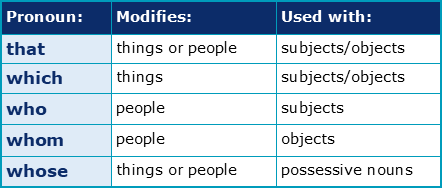Which 8 rules make relative clauses grammatical?

This is the third and final chapter about Relative Clauses. To complete this reader, read each chapter carefully and then unlock and complete our materials to check your understanding.
– Review the concepts of relative clauses in English
– Discuss the eight most important grammar rules of accurate relative-clause creation
– Complete the Lesson Worksheets to check progress and comprehension and improve English proficiency
Before you begin reading...
-
video and audio texts
-
knowledge checks and quizzes
-
skills practices, tasks and assignments
Chapter 3

Having completed Chapters 1 and 2, we should now know that relative clauses (also known as adjective clauses) are a type of dependent clause that must be attached to another clause to form a grammatical sentence. We’ve discussed how all clauses have to contain a minimum of a subject and a verb and we know that relative clauses directly follow the noun or noun phrase they define, identify or provide extra information for. We also recognise that relative clauses are most often introduced by relative pronouns such as ‘who’ and ‘which’ and that such clauses can be divided into twelve types.
In this final chapter on the topic, we explore the eight rules that will improve a student’s English grammar and knowledge of sentence structures if followed carefully. After completing this chapter and the associated worksheets (which have been designed to check progress and improve language proficiency), consider studying another short course on sentence clauses to expand your knowledge.
Rule 1: Know the 12 Types
Because some of the following seven rules relate specifically to certain types of relative clause, the first rule on our list is to make sure that you are familiar with the following six categories and their twelve subtypes (as explored in Chapter 2):
- Bound relative clauses (six types)
- Free relative clauses
- Restrictive relative clauses
- Non-restrictive relative clauses
- Reduced relative clauses (two types)
- Infinitival relative clauses
Rule 2: Punctuate Non-Restrictive Relative Clauses
The vast majority of relative clauses do not require punctuation to be grammatical. However, the use of bracketing commas (,) is necessary with non-restrictive relative clauses that provide additional (non-essential) information to the preceding noun or noun phrase. For example: ‘the final exam, which you may find difficult, is next Friday’. In spoken English, this nuance is usually indicated using pauses.
Rule 3: Use Relative Pronouns Accurately
Because almost all relative clauses (except for reduced relative clauses) are introduced with relative pronouns, it is important that students learn to use these words correctly. This is because some pronouns are able to introduce things and people while others can solely introduce one or the other. Whether the pronoun refers to a subject or an object also has an impact on its form:

In addition to these pronouns, restrictive, non-restrictive, reduced and free relative clauses can also be formed using the adverbs ‘when’ and ‘where’, as in ‘the year when we met’ or ‘the place where we met’. Though less common, free relative clauses may also be introduced using the pronouns ‘whomever’ and ‘what/whatever’.
Rule 4: Be Careful Using ‘That’
It’s key to remember that the word ‘that’ can only be used in place of ‘which’ or ‘who/whom’ in restrictive relative clauses, such as in example (A) below. It would be ungrammatical to use ‘that’ in a non-restrictive clause such as example (B):

Another rule is that ‘that’ can only be omitted in reduced object (C) and not reduced subject relative clauses (D):


Rule 5: Be Sparing with ‘What’
In some dialects of English, the pronoun ‘what’ is used frequently in place of ‘who’ and ‘which’. However, most English teachers would mark their students down if they used ‘what’ in this way, particularly in academic writing as this usage is considered too informal. The only time that it’s grammatical to use ‘what/whatever’ is when forming free relative clauses about things (not people) which are not bound to any preceding subjects or objects, such as how the phrase ‘what you submitted’ in ‘I graded what you submitted’ is an object to ‘grade’ and not an adjectival modifier.
Rule 6: Watch out for Prepositions
When there is a preposition such as ‘from’, ‘with’ or ‘to’ included in a relative clause, there are three rules that should be followed:
- i) In formal English, prepositions should be placed before the relative pronouns ‘whom’ and ‘which’.
- ii) In informal English, prepositions can be placed at the end of the clause when using the relative pronouns ‘whom’ and ‘which’.
- iii) Whenever a relative clause has a preposition and is introduced by the relative pronoun ‘that’, the preposition should always be placed at the end of the clause.
These three rules can be seen in the examples below:



Rule 7: Make Sure Nouns and Verbs Agree
Subject-verb agreement is another aspect of relative-clause grammar that students often get a little wrong. Remember that verbs and nouns should agree in person (first, second, third) and number (singular, plural). Because relative clauses, for the most part, define, identify or provide extra information about nouns and noun phrases, it’s important that the verb which follows a relative pronoun correctly agrees with its preceding referent noun phrase.


In the examples above, we can see that the interrogative pronoun ‘who’ in (A) would normally be singular and agree with the verb ‘teaches’. However, in expression (B) with a relative clause, ‘who’ refers to the preceding noun ‘people’ and as such must agree with that noun by using the plural form of the verb ‘teach’.
Rule 8: Know which Elements to Reduce
Finally, when creating reduced relative clauses which have words missing from their structure, there are three rules which should be followed:
- i) Object relative pronouns can be deleted for restrictive relative clauses only.
- ii) When deleting subject relative pronouns for restrictive relative clauses, the present participle form of the verb (i.e., ‘studying’) should be used.
- iii) When deleting subject relative pronouns with non-restrictive relative clauses, this is only possible with pronouns that precede a ‘be’ verb; both the pronoun and the ‘be’ verb should be removed.
Examples of each of these three rules are provided for you below:



Very well done on completing all three chapters in this short reader on relative clauses. Having downloaded and completed the Chapter Worksheets and activities, you should now be ready to study another course on the subject of sentence clauses. Best of luck in your study of English grammar!
Downloadables
Once you’ve completed all three chapters in this short reader about Relative Clauses, you might then wish to download our Chapter Worksheets to check your progress or print for your students. These professional PDF worksheets can be easily accessed for only a few Academic Marks.
Chapter 1 explores the topic: What are relative clauses and are they important? Our Chapter 1 Worksheet (containing guidance, activities and answer keys) can be accessed here at the click of a button.
Chapter 2 explores the topic: What are the 12 types of relative clause in English? Our Chapter 2 Worksheet (containing guidance, activities and answer keys) can be accessed here at the click of a button.
Chapter 3 explores the topic: Which 8 rules make relative clauses grammatical? Our Chapter 3 Worksheet (containing guidance, activities and answer keys) can be accessed here at the click of a button.
To save yourself 2 Marks, click on the button below to gain unlimited access to all of our Relative Clauses Chapter Worksheets. This All-in-1 Pack includes every chapter, activity and answer key related this topic in one handy and professional PDF.
Collect Academic Marks
-
100 Marks for joining
-
25 Marks for daily e-learning
-
100-200 for feedback/testimonials
-
100-500 for referring your colleages/friends